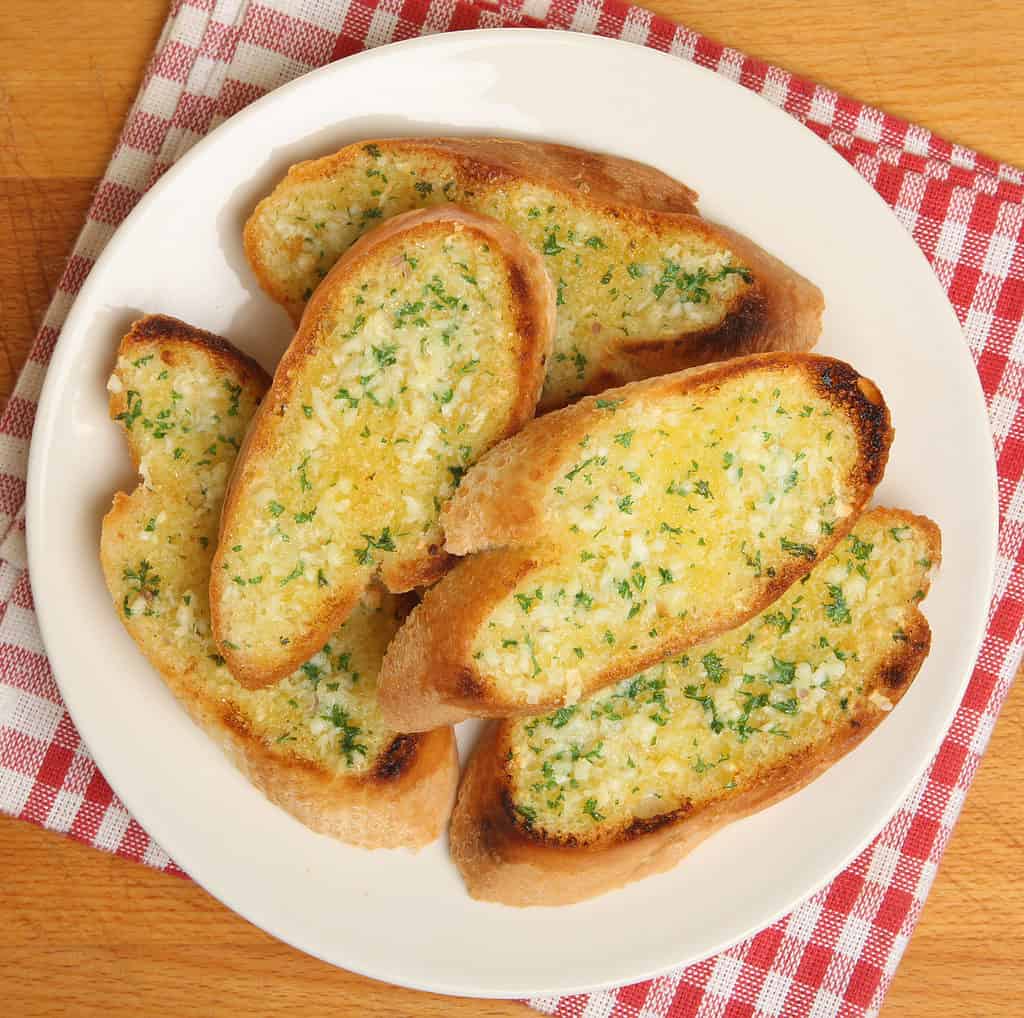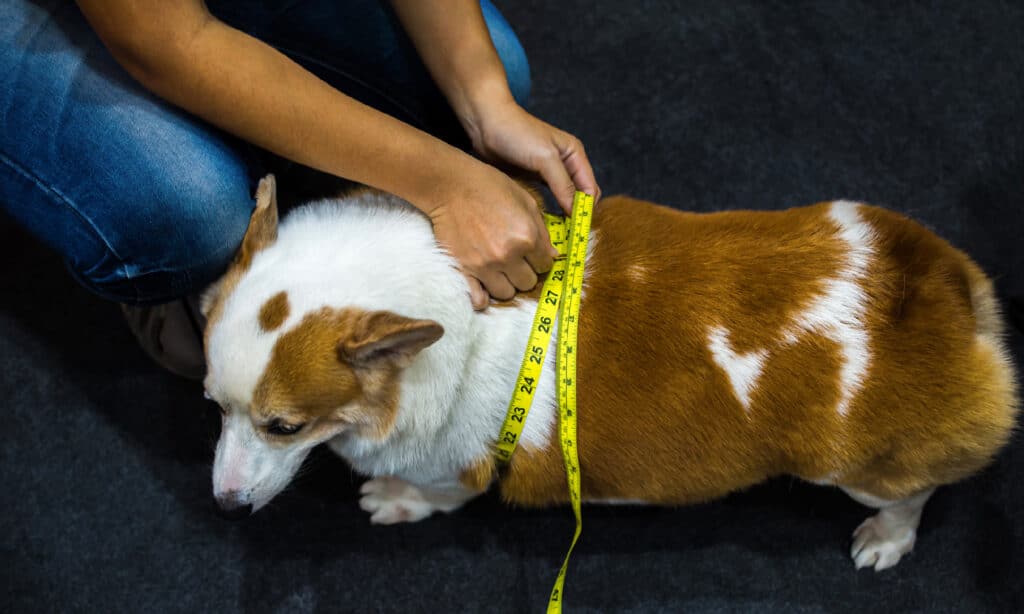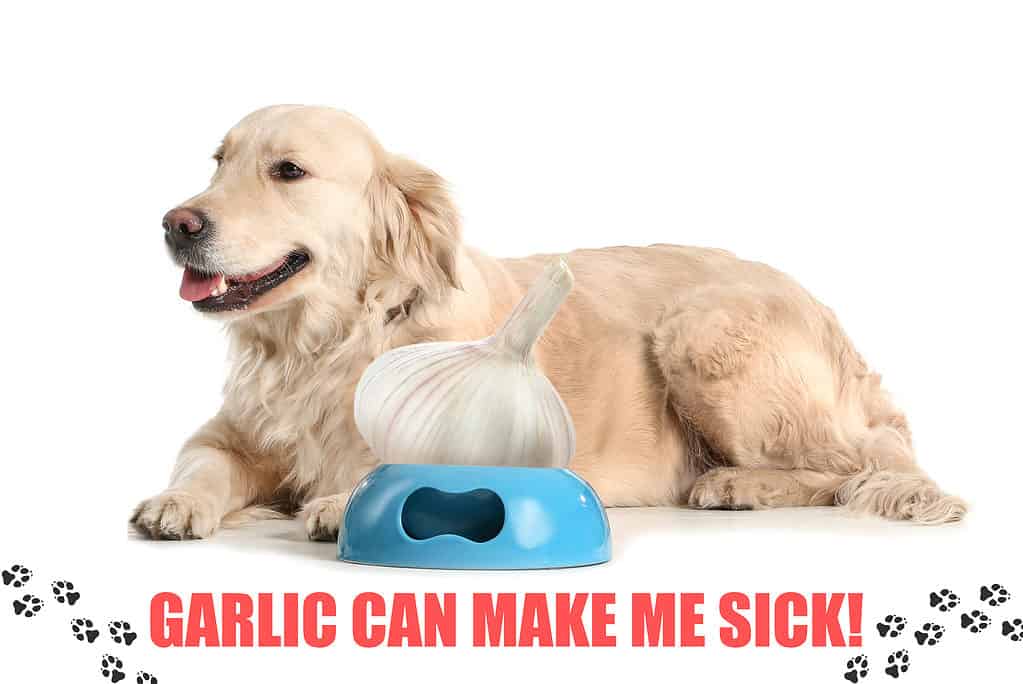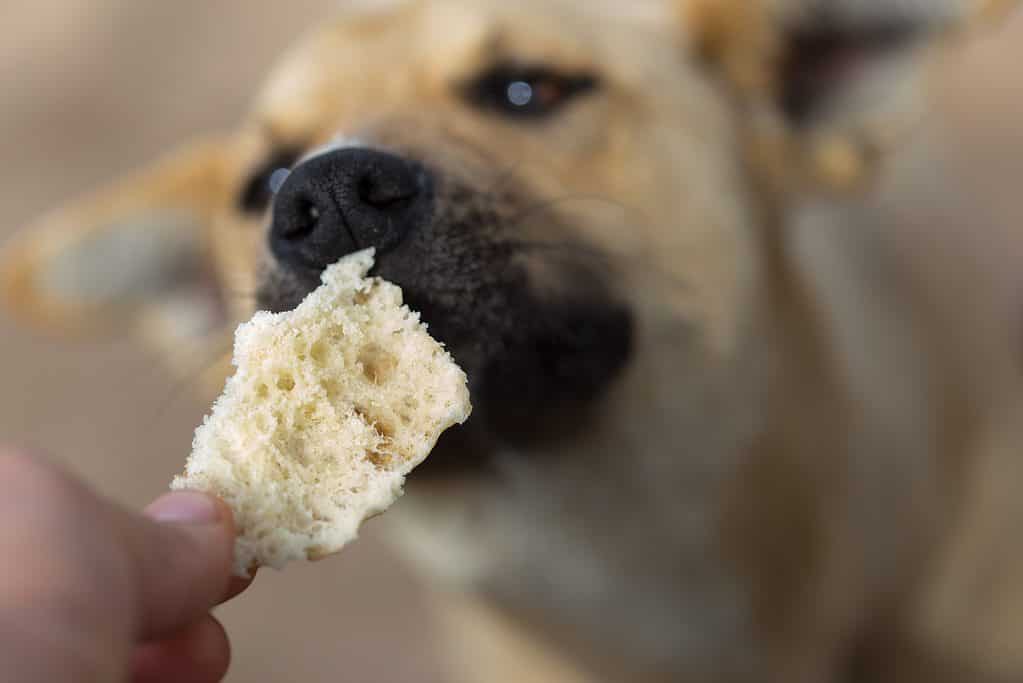Garlic and bread are two food pairings that sound bad on paper, but in reality they taste divine. It’s enjoyed by many people as a snack or accompaniment to Italian-style dishes, but can dogs eat garlic bread too, what happens if they snaffle the garlic bread when you’re not looking?
Garlic is toxic to dogs, but bread isn’t unless they have a wheat or gluten intolerance so what’s the score? Let’s take a close look to find out if dogs can share garlic bread.
Is Garlic Bread Safe For Dogs?
The quick answer is no. Garlic bread is not safe for dogs.
It’s because garlic is dog-toxic and in large quantities it can cause serious health issues. Garlic bread also contains a hefty amount of oil and butter which have the potential to make our canine friends sick.
Overall, it’s best that you eat garlic bread and give your dog a healthy snack like sliced bell peppers or apples instead.
What is Garlic Bread?
This tasty food is bread, usually a baguette, that’s topped with olive oil and garlic and then baked until it’s crusty and delicious (hands up if your mouth is watering!). It’s a very simple dish and some folk like to add extra toppings such as oregano, chives, or cheese.
Garlic bread has routinely been served up in American restaurants since the 1950s and sold in stores since the 1970s, but it’s much older than that. The ancient Greeks, Romans, and Egyptians all ate their own versions and it was a staple during medieval times, particularly in France.
Garlic was routinely used as medicine throughout these eras too. Garlic is a potent antiseptic, antiviral and antibacterial agent. It was applied to plague sores in the 1300s and to wounds in the trenches of WW1. It was a popular cure-all before penicillin was discovered.
But just because it’s good for us, it doesn’t mean it’s good for Rover. In fact, garlic is toxic for dogs.

Garlic bread has been enjoyed by many people as a snack or accompaniment to Italian-style dishes for decades but is not safe for dogs.
©iStock.com/JoeGough
Health Benefits of Garlic Bread
There are no health benefits because the risk of garlic toxicity outweighs anything else.
The Risks of Garlic Bread
Let’s start with the garlic problem.
Garlic is part of the allium family along with onions, shallots, leeks, chives, and flowering bulbs like the pretty Purple Sensation allium. All of them are dog-toxic.
Dogs can’t metabolize garlic. Instead, a compound called thiosulphate causes oxidative damage to their red blood cells and hemolytic anemia occurs.
This type of anemia causes rapid breathing, weakness, pale gums and eyelids, jaundice, dark-colored urine and a range of gastric distress like abdominal pain, diarrhea, and vomiting.
Pancreatitis
Butter and oil on garlic bread are another problem. There’s no doubt dogs love hot buttery foods, but fat can trigger pancreatitis, a really painful condition where the pancreas gets inflamed and releases its digesting enzymes when no food is present. With nothing else to do, these enzymes digest the pancreas. It’s painful distressing, and expensive to fix at the vet. Plus it’s likely to reoccur.
Obesity
Oils, butter and stodgy bread contribute to obesity. The Association for Pet Obesity Prevention suggests that 56% of dogs are overweight in the States, which adds up to around 50 million dogs. Being overweight limits a dog’s lifespan and makes diabetes, cancer, high blood pressure and mobility problems more likely.

Oils, butter and stodgy bread contribute to dog obesity which limits a dog’s lifespan.
©iStock.com/PongMoji
How Much Garlic Bread Can a Dog Eat?
Dogs shouldn’t eat garlic bread at all, but studies show it takes 15 to 30 grams of garlic to cause blood changes per kilo of weight.
A garlic bulb weighs around a maximum of seven grams, so your dog would need to eat a lot to get sick. However, garlic can build up over time and some dogs are more sensitive.
It also depends on your dog’s breed. Large dogs would be less affected by a slice of garlic bread than small chihuahua-size pooches.
Can Dogs Eat Garlic?
No. Dogs cannot eat any form of garlic even if it’s cooked. That includes garlic powder, infused oils, flakes, the bulb, and garlic supplements. Avoid flea supplements containing garlic unless your veterinarian has recommended otherwise.

Dogs cannot eat any form of garlic even if it’s cooked.
©Pixel-Shot/Shutterstock.com
How About Just Plain Bread?
Yes, dogs can eat bread, but it’s best fed in moderation and only on occasion.
Although bread is full of fiber, carbohydrates, vitamins and it’s relatively low in sugar, bread on a regular basis can lead to unhealthy weight gain which we’ve seen is a real problem for dogs in the US. The ASPCA recommends just 10% of a dog’s daily diet should be treat foods and 90% balanced complete dog food. That doesn’t give a lot of wiggle room for bread.
There’s also the potential for a wheat allergy or intolerance. Wheat intolerance is fairly common in dogs, so manufacturers are bringing out new gluten-free complete dog food to get around the problem.
The signs of gluten or wheat intolerance are decreased energy levels, poor coat condition, stomach pains, flatulence, diarrhea, vomiting, and general lethargy. If your dog has a problem with gluten or wheat, don’t feed them bread.
Just a quick note on the bread topic!
Raw bread dough is extremely bad for dogs and can be fatal. It’s because raw bread dough rises in the heat of a dog’s tummy distending it to painful proportions, and it releases a toxic amount of ethanol. If your dog snaffles raw bread dough, speak to a vet straight away.

If your dog has a problem with gluten or wheat, don’t feed them bread.
©donikz/Shutterstock.com
My Dog Ate Garlic Bread, What Should I Do?
Don’t panic.
Depending on your dog’s size a small amount of garlic bread won’t hurt them. We’ve seen it takes 15-30 grams of garlic per kilo of body weight to make blood changes, and a garlic bulb weighs around 7 grams. They would need to eat a lot to get sick.
Monitor your dog over the next few days to see if they react badly and call a vet if you’re concerned. A stomach upset could happen in dogs that are sensitive to garlic.
If this happens, give them lots of fresh water and small meals of plain food like turkey and rice or chicken with sweet potato to firm up their stools and keep that horrible hungry feeling at bay.
What Foods are Poisonous for Dogs?
Alongside all members of the allium family (that’s garlic, onions, shallots, chives, leeks, and flowering allium bulbs) dogs should avoid these foods and drinks:
Grapes and raisins
They look harmless, but sweet little grapes and raisins are toxic to dogs. Grapes can lead to liver and kidney failure in all their wine, juice, raisins, and sultana forms.
Xylitol
This artificial sweetener crops up in a wide range of foods from Jell-O to juice and low-sugar yogurts. It causes a big blood sugar drop and even fatal hypoglycemia.
Chocolate
Theobromine and caffeine in chocolate are stimulants that can lead to organ failure. Chocolate may also contain high levels of pancreatitis-inducing fat and toxic xylitol. It can lead to vomiting, diarrhea, collapse, and coma.
Macadamia nuts
Macadamia nuts are toxic even if they’re part of a cake or your pup has eaten just one. The tell tale sign is weak back legs, but lethargy, diarrhea, and vomiting are common too.
Alcohol
Ethanol in alcohol can poison dogs and even kill them. From beer, ale, spirits, wine, cocktails and alcohol-infused sweets keep booze away from pups who could be attracted to the sweet taste.
Is Garlic Bread Dangerous For Dogs?
Let’s recap on our question can dogs eat garlic bread? The answer is no, dogs should not eat garlic bread.
Although a stolen slice is unlikely to cause fatal consequences, feeding your doggo garlic on a regular basis is not recommended because it can cause anemia, plus the oil can trigger pancreatitis and rapid weight gain.
Treat Rover to carrot sticks, blueberries, or strawberries on occasion instead. Or maybe even a cheeky puppaccino if you’re feeling generous and your pooch is in top-notch health.
Up Next
- Can Dogs Eat Bread Safely?
- Should You Actually Let Your Dog Eat Ice Cream? Is It Safe?
- Can Dogs Eat Dried Apricots?
- Can Dogs Eat Sourdough Bread?
The photo featured at the top of this post is © Kaczleo/Shutterstock.com
Ready to discover the top 10 cutest dog breeds in the entire world?
How about the fastest dogs, the largest dogs and those that are -- quite frankly -- just the kindest dogs on the planet? Each day, AZ Animals sends out lists just like this to our thousands of email subscribers. And the best part? It's FREE. Join today by entering your email below.
Sources
- MSD Veterinary Manual, Available here: https://www.msdvetmanual.com/management-and-nutrition/nutrition-small-animals/nutritional-requirements-and-related-diseases-of-small-animals
- National Library of Medicine, Available here: https://www.ncbi.nlm.nih.gov/pmc/articles/PMC2984110
- ASPCA, Available here: https://www.aspca.org/news/animal-poison-control-alert-macadamia-nuts-are-toxic-dogs
Thank you for reading! Have some feedback for us? Contact the AZ Animals editorial team.






